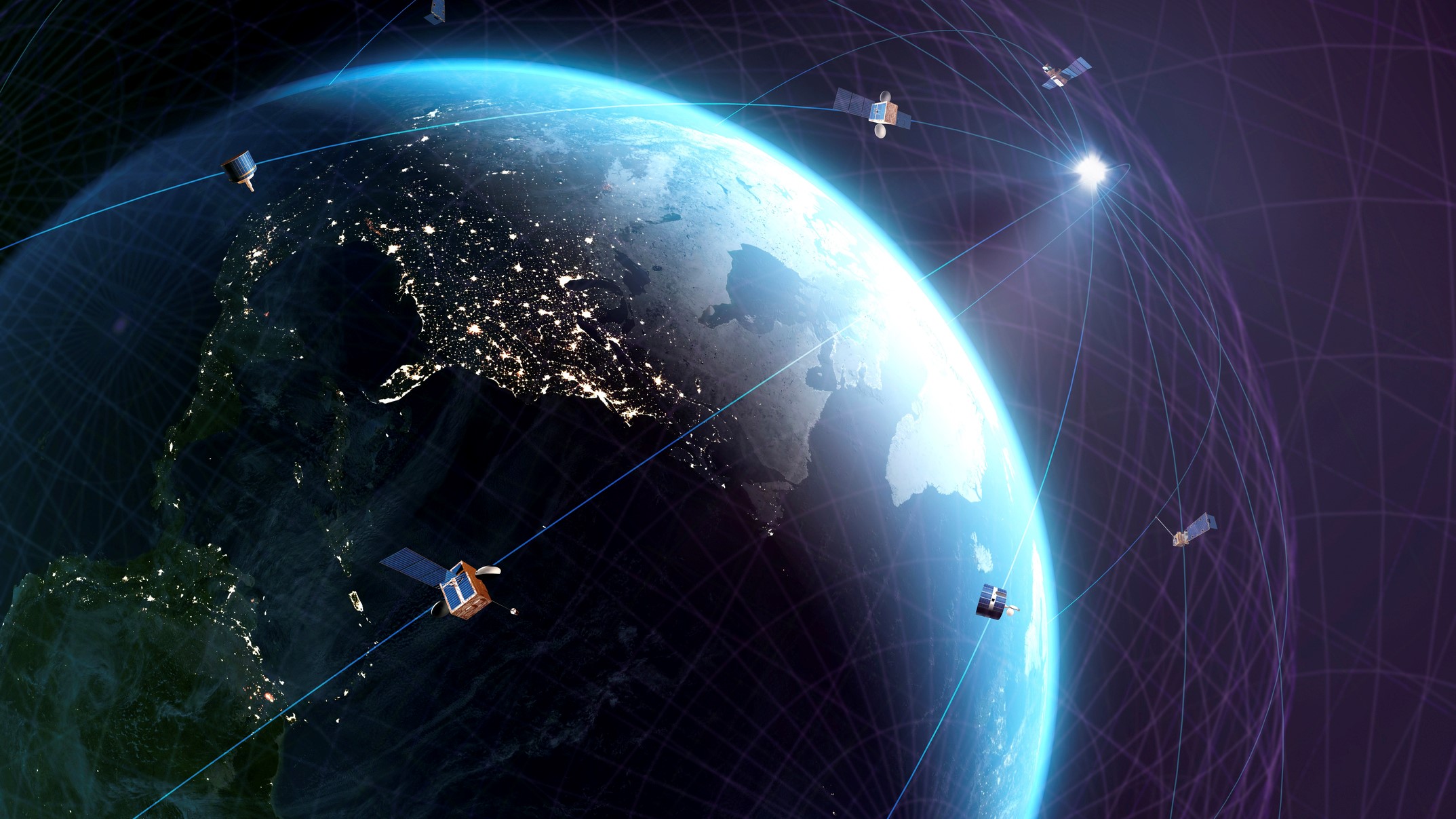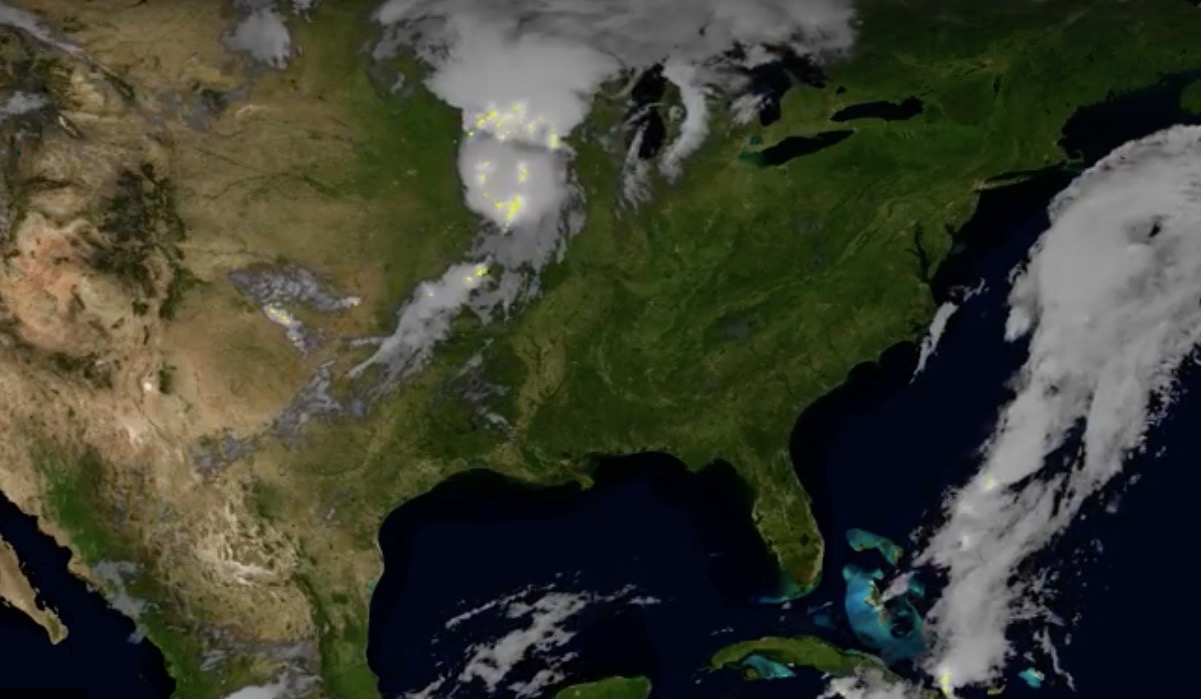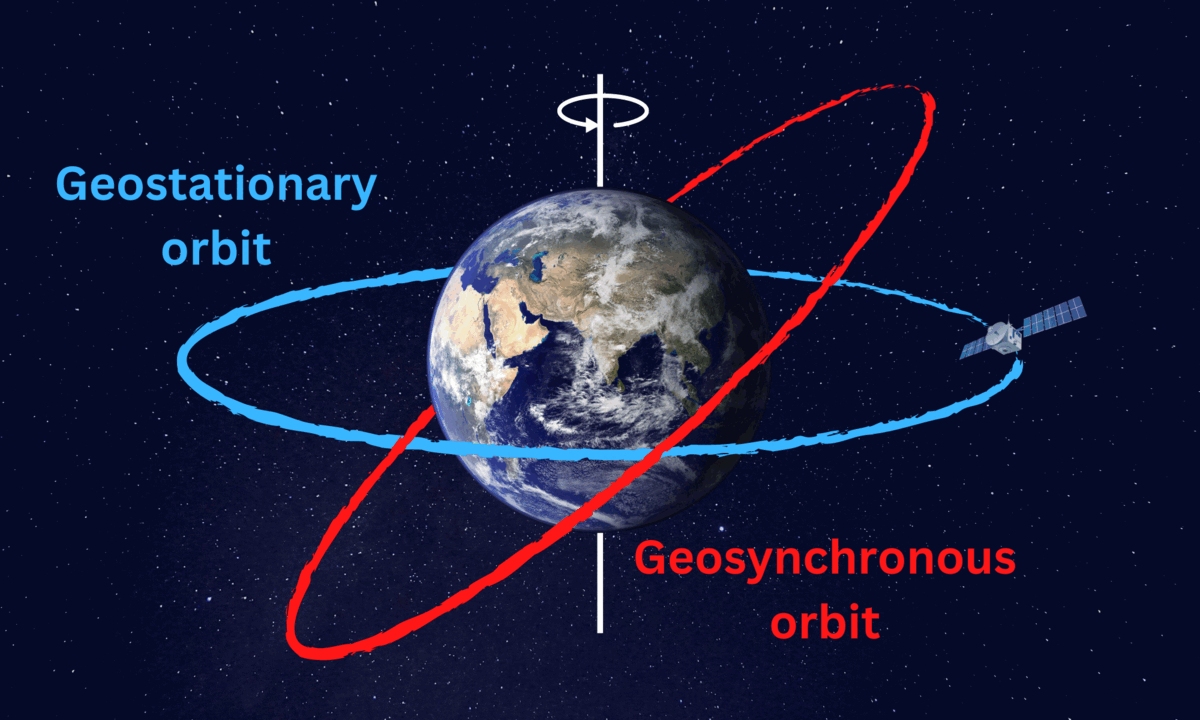What is a geosynchronous orbit?
Geosynchronous orbits are vital for communications and Earth-monitoring satellites.

A geosynchronous orbit is a special position high above the Earth that allows an object to keep pace with the rotation our planet.
In circular geosynchronous orbits, satellites are in a "sweet spot" in which they stay in the same location by longitude but may drift to the north and south, according to NASA Earth Observatory.
That means for observers on Earth, a satellite in a geosynchronous orbit would, for the most part, appear to be in a fixed position in the sky.
Related: How to see and track the International Space Station (ISS)
Holding the same location over Earth is extremely useful for satellites tasked with monitoring missions, tracking the weather and other remote sensing tasks, as well as being important for communications satellites.
Geosynchronous orbits are often also called "Clarke orbits" or satellites in this orbit are described as being in the "Clarke Belt" in honor of famous science fiction writer, Arthur C. Clarke.
In a 1945 letter to the publication Wireless World, Clarke described his vision of a machine in orbit that could facilitate communications across the globe.
Clarke's "artificial satellite" would be at the correct distance from the Earth to allow it to make one revolution every 24 hours. This would mean it remaining stationary above the same spot over Earth keeping it within range of optical signals for nearly half the planet's surface.
This was the first suggestion of such a geosynchronous orbit.
How high is a geosynchronous orbit and how does it work?

A satellite in a geosynchronous orbit holds the same position over Earth by matching the duration of its orbit to what is called Earth's sidereal day, the time required for the Earth to rotate once relative to its background stars, which is 23 hours 56 minutes 4 seconds.
Satellites are in geosynchronous orbits when they are located around 22,236 miles (35,786 kilometers), according to the European Space Agency (ESA). This altitude has to be constant for a satellite to remain in sync with the Earth's sidereal day.
This altitude is also much higher than other orbits meaning satellites in geosynchronous orbits are much further from Earth than those in other types of orbits making them the most distant satellites.
There are three main types of orbit around Earth, low Earth orbits, medium-Earth orbits, and high-Earth orbits. At first engineers and scientists utilized low-Earth orbits believing it would take too much energy to get a satellite to a high-Earth geosynchronous orbit.
Like all satellites, those in geosynchronous orbits remain there because by performing a balancing act between Earth's gravitational influence and their velocity. A satellite has to travel faster enough to "defeat" the downward pull of gravity.
Lower orbits require greater speed to maintain their altitude. This is because gravity follows an "inverse square law" and thus Earth's gravity is much weaker at high orbits.
In a geosynchronous orbit, to stay in sync with sidereal day and to avoid the downward pull of gravity the European Space Agency (ESA) says that satellites have to maintain a speed of around 7,000 miles per hour (11,300 kilometers per hour).
Geosynchronous orbits vs geostationary orbits

A geostationary orbit is actually a type of geosynchronous orbit. The key difference between a geostationary orbit and a geosynchronous orbit is while the latter can have any inclination, the former orbit sees satellites permanently 'parked' over the plane of Earth's equator.
In fact, NASA says that geostationary orbits are achieved by selecting a geosynchronous orbit that is perfectly circular described as having an eccentricity of 0 and an inclination of 0 right on the equator, or low enough that it can use propulsion to maintain its position over Earth.
Geosynchronous orbits and geostationary orbits are prograde, which refers to a spacecraft moving in the same direction as the planet's motion as opposed to retrograde when a spacecraft moves opposite to the rotation
What objects are in geosynchronous orbits
The fact that geosynchronous allow satellites to maintain a set position over the globe makes them particularly useful for weather monitoring, allowing scientists to continuously observe a specific area to see how weather trends emerge and develop.
An example of weather satellites around Earth in geosynchronous orbits are the National Oceanic and Atmospheric Administration (NOAA) Geostationary Operational Environmental Satellite (GOES) system satellites GOES East (GOES-16) and GOES West (GOES-17).
Another common use for geosynchronous orbits is communications. A satellite high above the Earth can cover so much of Earth that the ESA says it only takes 3 equally-spaced satellites to cover the planet.
Another advantage of a geosynchronous orbit is that aerials on Earth don't have to redirect or reposition to stay in touch with geosynchronous satellites that maintain the same position over Earth.
This has led to a wealth of communications satellites at high-Earth orbits from countries ranging from Mexico, the U.S., Canada, the U. K., Spain, and Russia. In addition to civilian communications, the U.S. military use satellites in geosynchronous orbits for communication purposes and to monitor areas of concern.
According to the satellite monitoring website Satellite Signals, as of August 2022, there were 539 active satellites in a geosynchronous orbit.
Because the safe and efficient operation of this multitude of satellites relies on them maintaining an appropriate distance from each other, the International Telecommunication Union (ITU) is responsible for assigning so-called "parking spots" slots for geosynchronous orbit satellites. The ITU also settles disputes between countries regarding frequency interference which can also arise if satellites get too close to each other.
In a paper published in 2000 in the Berkeley Technology Law Journal, Lawrence Roberts calculated that there are around 1,800 available "parking spaces" in geosynchronous orbit.
This calculation allows satellites to maintain a safe distance of around 2 degrees or around 0.62 miles (1 km) from each other. Though this calculation doesn't take into account the technical and operational requirements of individual satellites.
Additional resources
The stable orbits of satellites would be possible without considering the laws of both Isaac Newton and Johannes Kepler. You can read about the life of Keplar and his laws of planetary motion courtesy of NASA. Learn about the different types of orbits in more detail with these resources from the Center for Strategic and International Studies' Aerospace Security Project. See how many satellites are passing overhead right now with this live world map view of satellite positions from skywatching website In the Sky.
Bibliography
Geosynchronous vs Geostationary Orbits, GISGeography, [2022], [https://gisgeography.com/geosynchronous-geostationary-orbits/]
Planetary Orbits, Basics of Spaceflight, NASA, [Accessed 12/16/22], [https://solarsystem.nasa.gov/basics/chapter5-1/]
Types of orbits, ESA, [Accessed 12/16/22], [https://www.esa.int/Enabling_Support/Space_Transportation/Types_of_orbits]
Geosynchronous Orbit, Science Direct, [Accessed 12/16/22], [https://www.sciencedirect.com/topics/earth-and-planetary-sciences/geosynchronous-orbit]
S.Q. Kidder, SATELLITES AND SATELLITE REMOTE SENSING | Orbits, Encyclopedia of Atmospheric Sciences (Second Edition), [2015], Pages 95 -106
Geostationary orbit (GEO), ESA, [Accessed 12/16/22], [https://www.esa.int/Enabling_Support/Space_Transportation/Types_of_orbits#GEO]
Sidereal day, Britannica, [Accessed 12/16/22], [https://www.britannica.com/science/sidereal-day]
M.Mills, Arthur C. Clarke and the Global Communications Satellite, "Orbit Wars," The Washington Post Magazine, [1997], pp. 12–13.
Why Don't Satellites Fall Out of the Sky?, NESDIS, [Accessed 12/16/22], [https://www.nesdis.noaa.gov/news/why-dont-satellites-fall-out-of-the-sky]
L. D. Roberts, A Lost Connection: Geostationary Satellite Networks and the International Telecommunication Union, Berkeley Technology Law Journal, Vol. 15, №3 (Fall 2000), pp. 1095–1144
Join our Space Forums to keep talking space on the latest missions, night sky and more! And if you have a news tip, correction or comment, let us know at: community@space.com.
Get the Space.com Newsletter
Breaking space news, the latest updates on rocket launches, skywatching events and more!

Robert Lea is a science journalist in the U.K. whose articles have been published in Physics World, New Scientist, Astronomy Magazine, All About Space, Newsweek and ZME Science. He also writes about science communication for Elsevier and the European Journal of Physics. Rob holds a bachelor of science degree in physics and astronomy from the U.K.’s Open University. Follow him on Twitter @sciencef1rst.










